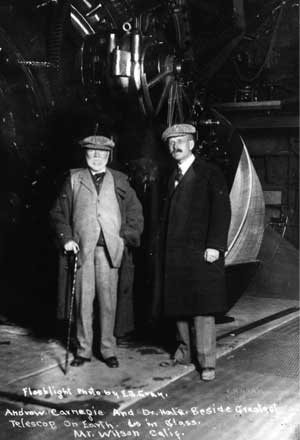History of Telescopes
By Daniel Kleppner

Credit: Photo by E. B. Gray, Mt. Wilson and Las Campanas Observatories, courtesy AIP Emilio Segré Visual Archives
Andrew Carnegie and George Hale standing in front of 60 inch telescope, Mt.Wilson, ca. 1908.
In honor of the 400th anniversary of the telescope, FHP sponsored an invited session on the history of the telescope on Saturday, May 2nd, 2009. The session opened with a presentation by Neville Woolf of the Steward Observatory on "The Bionic Telescope." He noted that the essential elements of Galileo's telescope live on, but that they have been totally transformed. The lens was long ago replaced by a mirror, and the observer's eye replaced by the photographic plate, which was itself replaced by CCD arrays of fantastic sensitivity. The housing -a simple tube - has been transformed into dynamical structures that hold massive mirrors in alignment to sub-wavelength precision. He described the modern era of telescopes as beginning in 1979 with the advent of mirrors cast in rotating ovens and the creation of multiple-mirror telescopes. A major advance in resolution followed the discovery that the limiting factor was often thermal accommodation. Thermal problems are ameliorated by using lightweight mirrors that allow tight thermal coupling to the atmosphere, and by carefully controlling the thermal environment so that the temperature does not change when the mirrors are exposed to the night sky. A second advance in resolution was enabled by the development of ground-layer adaptive optics. Towards this end, up to five laser beams are employed. These advances have made the diffraction limit achievable for large mirrors. Such adaptive optics enabled the first imaging of exoplanets. Woolf concluded with a description of the Giant Magellan telescope in which seven 8.4-m mirrors, their size limited only by the problem of transporting them to the observatory, will be joined to form a parent surface with a diameter of 25 m. In Europe, plans are being developed for such a telescope with 40 mirrors.

Credit: Photograph by Barnett Harris, AIP Emilio Segré Visual Archives, Physics Today Collection
Photograph was taken in 1921 when Albert Einstein visited the Yerkes Observatory at the University of Chicago, Williams Bay, Wisconsin. Visitors and staff posing with the 40‑inch telescope. (l‑r): Storrs B. Barrett, Lela D. Cable, John A. Parkhurst, Elsie E. Johnson, Dorothy W. Block, Florence B. Lee, Dorothy K. Sullivan, Edward E. Barnard, Arthur Jeffrey Dempster, Harriet M. Parsons, A. C. Lunn, Edwin B. Frost, Albert Einstein, A. Pflueger, S. Ginsberg, Oliver J. Lee, Esther L. Searles, Mary R. Calvert, George Van Biesbroeck, George C. Blakslee.
Christine Jones of the Harvard/Smithsonian Center for Astrophysics followed up with a talk on "Black Holes, Dark Matter, and Dark Energy: Measuring the Invisible through X-rays." The first observations of X-rays from the Sun were made in 1949 by Herbert Friedman of the Naval Research Lab, but it was Riccardo Giacconi, then at American Science and Engineering, who really pioneered X-ray astronomy during the 1960s. In 1962 he noticed X-rays reflected from the surface of the moon, and three years later, using an X-ray telescope fixed to a rocket, observed hot spots in the Sun. The first observations of non-solar X-rays came in 1978-81, by the Einstein Observatory and the Roentgen Satellite, or ROSAT. But it was the Chandra X-ray Observatory launched in 1999 that really broke the field open, said Jones. Using the glancing reflections of X-rays from hyperbolic cylindrical mirrors, Chandra has achieved a resolution of 1 arc-sec and has been able to resolve the heretofore "diffuse" X-ray background into a profusion of point sources. Perhaps its most telling discovery is the Bullet Cluster, a bullet-shaped region of hot gas due to a collision of galaxies. By comparing X-ray images (which trace only baryonic matter) with maps of the same region made using gravitational lensing (which traces all matter, baryonic or not), researchers have produced a stunning visual image that demonstrates the existence of dark matter beyond reasonable doubt.
Paul Vanden Bout of the National Radio Astronomy Observatory (NRAO) ended the session with an excellent talk on the history of radio astronomy. It began with Karl Jansky of Bell Labs, who, while searching for sources of static in 1933, discovered 14.6-m radiation moving across the sky at the sidereal rate - coming largely from the Milky Way. In 1937, Grote Reber began observations using a 31-foot reflector built in his back yard; he eventually worked his way down to 160 MHz and published maps of the radio sky in 1944. After the War, with surplus radar reflectors becoming available from military sources, the field of radio astronomy exploded. Van den Bout briefly noted the structural details and major contributions of the Areceibo radio telescope in Puerto Rico, the Mark I at Jodrell Bank in Britain, and the 300-ft NRAO telescope - all tracing back to the 1950s. But it was a small horn receiver at Holmdel, NJ, originally built by Bell Labs for satellite communications, that allowed Arno Penzias and Robert Wilson to make what he called "the biggest discovery in radio astronomy" - of the cosmic background radiation. A few years later another astounding discovery was made with a low technology receiver. This was the discovery of pulsars by Jocelyn Bell and Anthony Hewish, who worked with a large wire-array receiver. More recently, highly sophisticated radio receivers in the COBE and WMAP satellites have revolutionized our understanding of the early universe by discerning ever-so-subtle ripples in the otherwise uniform cosmic background radiation.
Note Added: This article represents the views of the author, which are not necessarily those of the FHP or APS.
